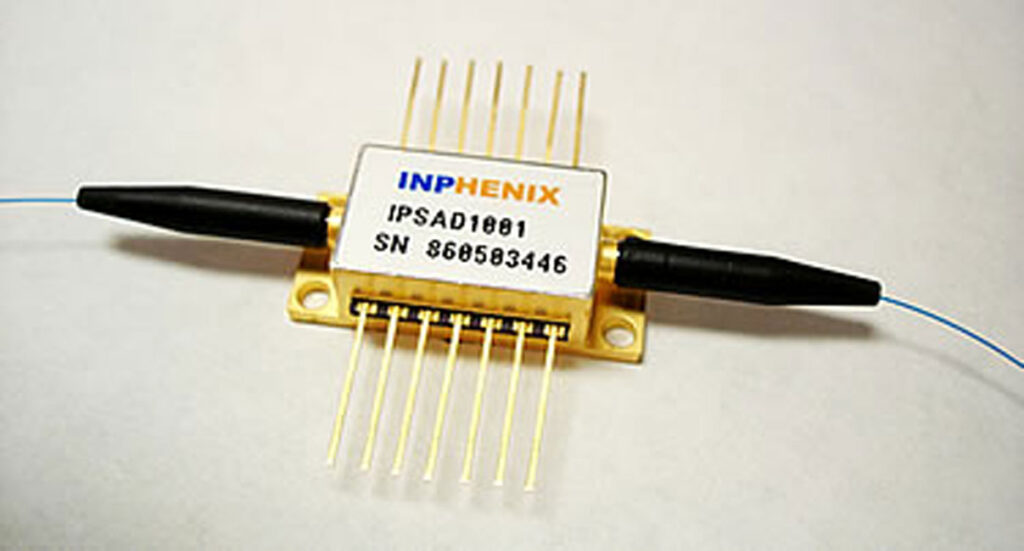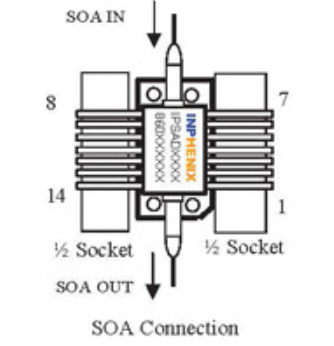
With its advent in the 1990s, semiconductor optical amplifiers defeated regenerator technology and paved the way for WDM technology. It is mostly used to directly magnify an optical signal without first converting it to an electrical signal. Optical amplifiers are classified into three types: Raman amplifiers, erbium-doped fiber amplifiers (EDFAs), and semiconductor optical amplifiers (SOA). This article will provide a more thorough introduction to SOA amplifiers and discuss their benefits and drawbacks.

Semiconductor Optical Amplifier is a device whose primary purpose is to amplify optical signals by stimulated emission, resulting in a gain. Gain is obtained by current injection in the case of semiconductor optical amplifiers. Its advantage is that it can increase the optical intensity of a signal without converting it to electrical signals and back again.
The semiconductor is utilized as the gain medium in semiconductor optical amplifiers, which are intended to be employed in general applications to improve optical launch power to compensate for the loss of other optical devices. Semiconductor optical amplifiers in the form of fiber-pigtailed components are often used in telecommunication systems, working at signal wavelengths ranging from 0.85 m to 1.6 m and providing gains of up to 30 dB. Semiconductor optical amplifiers with wavelengths of 1310nm, 1400nm, 1500nm, and 1600nm can be utilized with either single mode or polarisation preserving fiber input/output.
For stimulated amplification of an optical signal, an amplifier requires optical gain but not a resonant cavity. So, by simply removing the optical feedback mechanism of a semiconductor laser, a semiconductor optical amplifier (SOA), also known as a semiconductor laser amplifier, may be created.
The basic operation of a semiconductor optical amplifier is the same as that of a semiconductor laser, but without feedback. SOAs increase incident light through stimulated emission. As light passes over the active area, these electrons lose energy in the form of photons and return to their ground state. The stimulated photons have the same wavelength as the optical signal, increasing it.
Gain, gain bandwidth, saturation output power, and noise are the main metrics used to define an SOA amplifier.
Longer transmission lengths are necessary due to the fast expansion of optic communication networks. The needs of optical communication networks can be met by optical amplifiers. An optical amplifier is a device that directly amplifies an optical signal without converting it to an electrical signal first. An optical amplifier can be thought of as a laser without an optical cavity or one that suppresses feedback from the cavity.
In order to get over the fiber loss constraint, semiconductor optical amplifiers are a crucial component of optical communication networks. They allow for the transmission of many terabits of data over lengths of several hundred to thousands of kilometers.
Optical networks will heavily rely on wavelength converters. An optical device called a wavelength converter is used to change a light signal that has been injected from one wavelength to another.
A technique known as dense wavelength division multiplexing (DWDM) combines data from various sources onto an optical fiber while simultaneously transmitting each signal at a distinct wavelength.
By assigning various incoming optical signals to particular light frequencies (or wavelengths) within a designated frequency band and multiplexing them onto a single fiber, a technique known as wavelength-division multiplexing (WDM) boosts a fiber’s ability to transmit information. New varieties of laser diodes and semiconductor optical amplifiers are among the technologies that support WDM and DWDM.
The use of semiconductor optical amplifiers in Wavelength Division Multiplexing-Passive Optical Networks has given them a broader position in the telecom industry (WDM-PON). Nodes, or distribution centers, are frequently used by cable companies to help with data switching and routing from the home office to the client receiving the data. This configuration makes it possible to efficiently distribute data to a sizable consumer base. Although SOAs are a young use of WDM-PON, they might expand in the future.
Before being transmitted down fiber, a pre-amplifier transmitter signal is amplified by the power amplifier. A booster increases an optical signal’s power to the highest possible level to optimize transmission distance. Based on the amplifier gain and fiber losses, a power amplifier can extend the transmission distance by 100 km or more. Because the input signal is rather large and directly from a transmitter, the major requirement of this amplifier is to provide maximum output power rather than high gain.
The so-called preamplified optical receiver in optical receiver is frequently created by placing a preamplifier right before the photodiode. The noise level of a preamplifier should be low in addition to having a high optical gain requirement as its primary requirement.
In-line optical amplifiers (line-amps) are used to compensate for the attenuation induced by optical fibers throughout the transmission system. Line-amps are frequently placed regularly throughout a fiber connection in high-speed optical transmission systems, one for every 80 km of transmission distance.
Currently, semiconductor optical amplifiers with unique designs are created for use as amplifiers. Due to their strong nonlinearity, SOAs have received significant attention for all-optical switching applications in addition to their use as straightforward amplifiers.
A device known as an optical amplifier is one that amplifies an optical signal without first converting it to an electrical signal. A semiconductor optical amplifier can be compared to a laser without an optical cavity or one where cavity feedback is muted. In optical communication and laser physics, optical amplifiers are crucial. In the long-distance fiber optic cables that carry the majority of the world’s telecommunication links, they serve as optical repeaters.
Another significant industry using semiconductor optical amplifiers in a variety of applications is sensing. The Fiber-Bragg Interrogators are an essential SOA application in sensors. The input light source in this configuration can be either an SLD or a DFB. In order to control the optical signals’ direction, an SOA frequently uses a circulator as a means of boosting optical signals to fiber-bragging gratings (FBG). The wavelength or timing of the optical signals to a PD/sensor is altered by changes in temperature or strain. This can warn the user of potential problems.
Semiconductor optical amplifiers are used for the purpose of medical diagnostics and imaging.
In the front-end RX and TX signal chains of contemporary medical equipment, such as smart ultrasound probes, accuracy measurements and high efficiency are essential.
Real-time image processing employing better resolution analog-to-digital converters is required for use with additional imaging apparatus such as CT and PET scanners (precision ADCs). A low-noise precision amplifier, like the OPA392, produces a very low broadband noise of 4 nV/Hz, which helps lower the total system error while maintaining linearity and signal integrity.
Precision amplifier selection criteria have to be based on process technology that allows for increased efficiency without compromising noise and size. In comparison to their CMOS or JFET equivalents, bipolar op amps are generally renowned for having better noise-to-power ratios.
Conclusion
Semiconductor Optical Amplifiers are a low-cost, high-performance option for long-distance WDM networks. Because of its characteristics, SOA amplifiers may be utilized in Booster and in-line amplification, an optical network, general purpose tests and measurements, and fiber sensing. It does, however, have certain restrictions. Electron-hole recombination happens in semiconductor optical amplifiers, affecting the overall performance of the line.
Inphenix is a US-based company established in 1999. We specialize in manufacturing optical devices such as swept-source lasers, FP lasers, gain chips, distributed feedback lasers, and VCSELs. Our products are cutting-edge and work with a broad variety of devices.
An SOA (Semiconductor Optical Amplifier) is a light-amplifying semiconductor element. To erase the resonator structure, antireflective processing is given to both sides of a semiconductor laser. As the light reaches the semiconductor from the outside, it is amplified through stimulated emission.
Semiconductor optical amplifiers (SOAs) may be used for a variety of purposes beyond only boosting optical signals. Optical switching, all-optical signal processing, demultiplexing, regeneration, and wavelength conversion all make use of it as a crucial component.
Semiconductor optical amplifiers are small and electrically pumped devices. EDFA has a lower output power and is less costly. It is possible to run it with a low-power laser. It supports all forms of nonlinear operations such as cross-phase modulation and cross-gain modulation.
InPhenix offers the following products related to this article. Please visit these pages if you are interested in this article.

